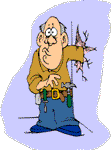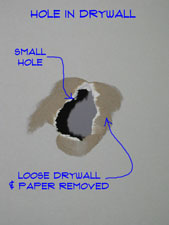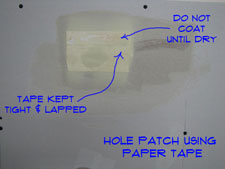 Learning how to patch small holes in drywall will not take you very long and you will save both time and money in the future. You may already have the tools and the materials are inexpensive.
Learning how to patch small holes in drywall will not take you very long and you will save both time and money in the future. You may already have the tools and the materials are inexpensive.
When it comes to holes in drywall, size does matter. There are three categories of holes that need to be patched and repaired. Check to make sure you are reading the right information for the problem you have.
Small Holes, Dents and Dings
Really small holes like nail holes or the holes left from picture hangers can usually be fixied with spackling. No need for mud, tape and pieces of drywall. This type of hole is the easiest to fix.
Spackling small holes in drywall only takes a few minutes and a little sanding. If you are preparing a wall for a fresh coat of paint, you want to see the article 'How To Spackle a Wall' for a complete discussion on this type of repair.
How To Patch Small Holes in Drywall
Let's say you move a piece of furniture or an appliance into your home and you put a deep gouge into the wall. Another scenario might be a full blown hole the size of a quarter in the drywall. No questions asked on how it got there, but it is definately more that you are going to be able to fix with spackling.
Holes of this type cannot be fixed with just a little spackling compound. However, they are not big enough to require new drywall to be installed. You have just entered into the world of fixing holes with tape and drywall compound. Yes, you can fix a wide variety of seemingly serious drywall problems with some paper or fiberglass tape and some all purpose drywall compound.
For this type of hole, you are reading the right series of articles. See below for more information and links to the steps involved with this type of repair.
How To Patch a Large Hole in Drywall
For big holes you need a bigger solution. Suppose the appliance tore a hole in the drywall that your dog could fit through while your were moving it. Spackling and tape are not going to fix this problem. You are going to have to replace some drywall.
This is not the end of the world, just a bit more work. It will also involve a little more material. See the series of articles on 'How To Patch a Large Hole in Drywall', for complete instructions on what to do.
How To Patch Small Holes in Drywall - The Issues
What Can You Save? - Patching a small hole will involve taping, which involves drying time. Even with quick setting compound you can be looking at one to two hours to take care of something. When it is your house you can go an do other things. Someone you hire will either wait or make return trips. The size of the patch matters but let's say between $100 and $200 dollars to hire someone to repair drywall in your home.
How Hard Could It Be? - Patching small holes in drywall will require taping and that takes a bit of practice and patience. These repairs will have a Difficulty Level of: A Bit of Work. These repairs require a Skill Level of: Skill Level Here. For and explanation of the terms in this section, see 'How to Use This Site'.
Check the Simple Things! - See if it is just an indentation before you use tape and mud. Small holes and indentations can be repaired with just compound or spackling. Go to the article 'How to Spackle Drywall', for more information.
What Can Go Wrong? - Using the wrong size knife can make a mess of the spot you are trying to fix. Failing to take your time and make sure that the drywall hole patch is smooth can leave a patch that will show after it is painted. You would be amazed at how unforgiving drywall can be when the right light hits it. Drywall is messy in it's own way, take precautions to deal with the mess. That is only needed if you care what your spouse will say.
Preparation for Drywall Patches

The first step in making a drywall hole patch is the hardest and most time consuming. You need to prep the hole to make sure you are not taping over loose material.
If you apply drywall compound over loose material you will get poor results. The mud will flake away since it is not attached to anything that is solid. Make sure everything is tight before you start applying drywall compound.
With a sharp utility knife (be careful, it cuts skin to) carefully cut away any loose paper. Remove any loose gypsum from the hole. Got it cleaned out? Good now you are ready for the tape.
At this point, you want to determine if you can patch this hole with just tape. It may have looked smaller before you removed all of the loose paper.
Is the hole smaller than the width of the tape? If it is, you can safely patch it with with mud and tape. Is it bigger? See the article 'Repairing Bigger Holes in Drywall' for information on what to do.
Taping and Finishing Drywall Patches

Taping and mudding a drywall hole patch will involve three or four steps. Make sure let the mud dry between each application.
The following is the steps you need to follow to tape and finish the drywall hole patch. For complete instruction of drywall finishing, see the article 'Taping and Mudding Drywall'.
Applying the Drywall Tape
You can use paper drywall tape or fiberglass mesh tape to repair the hole. Mesh tape is preferred by most pros for patching since it saves you a step.
Make sure you completely cover the crack and have the tap onto solid wall surface. This may mean that you have more than one width of tape. If you use paper tape, make sure you have compound between the layers of tape.
Coating the Crack With Compound
 You will likely have to apply two coats of compound and a skim coat to get a nice finish. Lightly sand the high spots down between each coat.
You will likely have to apply two coats of compound and a skim coat to get a nice finish. Lightly sand the high spots down between each coat.
Do not try to do too much with each pass. The first coat will be the heaviest. You want to completely cover the tape and feather the edges toward the flat surface of the wall.
Allow the drywall mud to completely dry before you apply another coat of mud. This is a common mistake, being impatient. If the mud underneath is not dry it will roll up and make a mess of your patch.
Skim the repair with a wide knife on the third pass to eliminate in hollow spots and tool marks left from the previous passes. See the article 'Taping and Mudding Drywall', for additional instructions.
Sanding and Painting
Sand the repair lightly until you have a smooth surface suitable for paint. Paint the wall and the hole in your wall is gone.
Summary
OK, it was several steps, but none of them should have taken that long. The trick is to be patient. Taping and first coat are the most work. You have to shape the patch on this step. After that it gets easier. Except for the sanding, no one likes to sand.
Allow a drywall patching job to run over the course of a couple of days. Find other things to do while the mud is drying. We hope your drywall hole patch has been a successful project. Now that you are done with it you can start living your life again.

